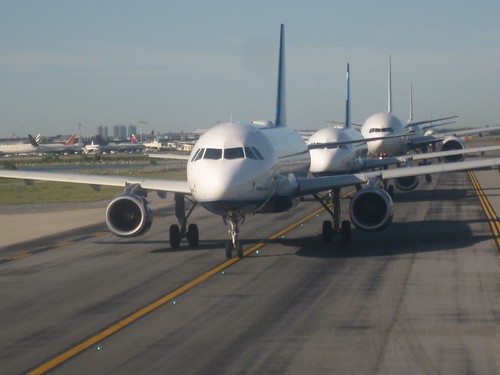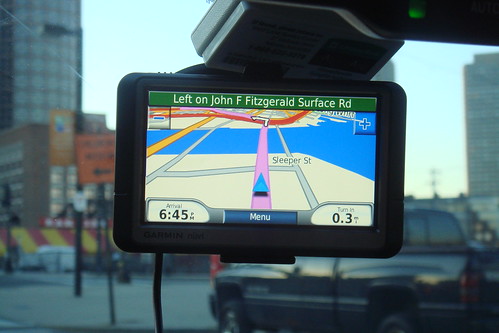(Sources contributing to this hybrid report: Green Car Congress; Fast Lane – Sec. LaHood’s Blog; Autoblog; Detroit News; LA Times; Business Week)
Finally, the curtains came down on the Cash For Clunkers program on Monday @8PM. After much hype and chaos the program closed its doors with a mixed record. Secretary LaHood calls is a great success while some others say no pointing to the choas around the program’s final days when the computer systems crashed as the dealers tried to submit their transcation data for reimbursements. In anycase, the program has left a wonderful memory in the minds of many economists and possibly underlined the fact that indeed the Government has some clever tricks up the sleeves to stimulate a lagging economy, especially for the automakers whose future looked very gloomy before this program came in to place.
After one month, an extra $2 billion in funding and an absolute mess of paperwork, Cash for Clunkers has finally petered out. The final numbers are in and the program resulted in 700,000 sales totaling $2.877 billion in $3,500 and $4,500 vouchers handed out at dealerships across the nation. An additional $100 million was set aside for administration costs, or about $144 for every claim processed, leaving $23 million in the kitty.
The program offered consumers rebates of $3,500 or $4,500 off the price of a new vehicle in return for trading in their older, less fuel-efficient vehicles to be scrapped. The trade-in vehicles needed to get 18 miles per gallon or less.
Here are some interesting snippets collected from various sources around the web (thank me for making it easy for you).
- The US Cash for Clunkers program (CARS) ended Tuesday night with 690,114 dealer transaction submitted worth $2,877.9 million.
- Eighty-four percent of consumers traded in trucks and 59% purchased passenger cars.
- The average fuel economy of the vehicles traded in was 15.8 mpg and the average fuel economy of vehicles purchased is 24.9 mpg: a 58% improvement.
- Cars purchased under the program are, on average, 19% above the average fuel economy of all new cars currently available.

Image Courtesy: Green Car Congress
Green Car Congress notes that Toyota reaped the largest percentage of sales under the CARS program (19.4%), followed by GM (17.6%) and Ford (14.4%). Honda came in fourth at 13.0%.
The top 10 vehicles purchased under the program were:
- Toyota Corolla
- Honda Civic
- Toyota Camry
- Ford Focus FWD
- Hyundai Elantra
- Nissan Versa
- Toyota Prius
- Honda Accord
- Honda Fit
- Ford Escape FWD
Top 10 Trade-in Vehicles:
- Ford Explorer 4WD
- Ford F150 Pickup 2WD
- Jeep Grand Cherokee 4WD
- Ford Explorer 2WD
- Dodge Caravan/Grand Caravan 2WD
- Jeep Cherokee 4WD
- Chevrolet Blazer 4WD
- Chevrolet C1500 Pickup 2WD
- Ford F150 Pickup 4WD
- Ford Windstar FWD Van
David Kiley at Business Week says that the annualized selling rate for the auto industry in August is expected to be about 15.5 million, thanks to C4C, according to Wall Street firm Goldman Sachs. That would be a 16% improvement year over year, and nearly a 40% increase from July. Goldman fully expects a “pay back effect” in September following the program. The firm also expects the monthly selling rate to remain above 10 million for the rest of the year, with a final sales tally of about 10.5 million, with a tally of 12 million next year. Some other analysts have pegged next year’s selling rate at 12.5 million to 13 million.
David also observed that while the program did its job, its real contribution has been less than the hype. Cash for clunkers did spur sales. It sold 690,000 cars and many were compacts like the Ford Focus and Honda Civic. So it did accomplish the mission of scrapping some old iron and selling some more efficient cars. That said, the boost will amount to less than a 3% increase for the year. That’s hardly the windfall that Germany achieved from a similar program, which pushed sales up an average of 30% a month since March. There may also be a hangover in car sales in the U.S. Edmunds says that purchase intent is now down 11% from June, meaning that fewer people are looking at new cars. So sales could slump in the coming months. In fact, J.D. Power says that more than 70% of sales may have happened later this year even if the government hadn’t spent $3 billion on the clunker program. One other point: Toyota was the biggest beneficiary, getting 19.4% of sales, with General Motors getting 17.6% and Ford getting 14.4% of sales from the program.
David Kiley says that “Clunkers” was good policy for a number of reasons (all of which I agree wholeheartedly):
- There is no question that the program brought many car buyers off the sidelines, and gave automakers, and dealers, a shot in the arm not only in terms of sales of the vehicles that qualified, but in vehicle sales in general as the program brought lots of new eyeballs to the entire showroom, not just the models that qualified.
- The $3 billion had direct impact on the economy, keeping people working, increasing production and shift work at auto companies and parts makers. Unlike other pieces of economic stimulus, the money was allocated and went directly into the economy. The money isn’t sitting on a shelf waiting for building permits to make it through local bureaucracies.
- Clunkers put a spotlight on the whole idea of trading up in fuel economy. Lots of old Explorers got swapped for Ford Focuses and Toyota Corollas. I believe U.S. public policy must move toward engineering a substantial change in transportation. There needs to be more policy that persuades people to choose their vehicles in a smarter way, to leave a smaller carbon imprint. This Clunkers bill was, perhaps, a start of a recurring series of moves that will create a more fertile atmosphere and public discussion about this.
- Perhaps the undeniable efficiency of Clunkers will influence policy-makers and lawmakers the next time they draft a stimulus package. Economist Martin Feldstein warned us when the stimulus was being debated that it was not targeted nearly enough to consumer spending. His notion, which I agreed with, was that money should have been highly targeted to spending on specific high-impact sectors—cars, major appliances, home improvement.
The USDOT’s press realease observed that according to a preliminary analysis by the White House Council of Economic Advisers, the CARS program will (1) Boost economic growth in the third quarter of 2009 by 0.3-0.4 percentage points at an annual rate thanks to increased auto sales in July and August. (2) Will sustain the increase in GDP in the fourth quarter because of increased auto production to replace depleted inventories. (3) Will create or save 42,000 jobs in the second half of 2009. Those jobs are expected to remain well after the program’s close.
Sec. LaHood says “This is a win for the economy, a win for the environment and a win for American consumers”. He noted in his blog “CARS’ economic success has been some of the most heartening news. Both Ford and General Motors haveannounced production increases for their third and fourth quarters due to heightened demand for fuel-efficient vehicles. Honda is also increasing production at its U.S. plants in East Liberty and Marysville, Ohio and in Lincoln, Alabama. The program has been a lifeline to auto manufacturers and dealers to be sure. But it’s also had a visible ripple effect through communities and related industries. Because of CARS, scrapyards are selling clunker waterpumps, batteries and other parts. Credit unions and banks are processing thousands of car loans. Repairmen, mechanics and sales staff are picking up additional work. CARS has truly been a winning deal for everyone. ” The USDOT’s press release also offered the following statistics:
Vehicles Purchased by Category
- Passenger Cars: 404,046
- Category 1 Truck: 231,651
- Category 2 Truck: 46,836
- Category 3 Truck: 2,408
Vehicle Trade-in by Category
- Passenger Cars: 109,380
- Category 1 Truck: 450,778
- Category 2 Truck: 116,909
- Category 3 Truck: 8,134
84% of trade-ins under the program are trucks, and 59% of new vehicles purchased are cars. The program worked far better than anyone anticipated at moving consumers out of old, dirty trucks and SUVs and into new more fuel-efficient cars.
Average Fuel Economy
- New vehicles Mileage: 24.9 MPG
- Trade-in Mileage: 15.8 MPG
- Overall increase: 9.2 MPG, or a 58% improvement
Cars purchased under the program are, on average, 19% above the average fuel economy of all new cars currently available, and 59% above the average fuel economy of cars that were traded in. This means the program raised the average fuel economy of the fleet, while getting the dirtiest and most polluting vehicles off the road.

Image Courtesy: Green Car Congress
Industry experts are now saying that after the ‘party’ of the Cash for Clunkers scheme, the auto industry will now experience a ‘hangover’, with a large drop in sales due to the lack of incentives. Auto research firm Edmunds.com predicted Wednesday that the industry “is likely to experience a painful hangover” after the monthlong cash-for-clunkers party. “People rushed into purchases that many would otherwise have made later this year. The result will be lower sales in the weeks to come,” said Edmunds Chief Executive Jeremy Anwyl. The number of people who intend to buy a new car in the next two months was down 50% from the peak of the clunkers program and 11% from the average in June, the firm said.
Figures released Wednesday showed that California auto dealers requested the most in reimbursements, $326.8 million, followed by those in Texas, New York and Illinois. Timely payment to dealers, some of whom are owed more than $3 million, will be a key measure of the program’s effectiveness, industry spokesman Wood said. Michigan ended up with $132.4 million in vouchers sought under the cash for clunkers program, the eighth highest among states. California was first at $327 million followed by Texas, New York, Florida Illinois, Pennsylvania and Ohio.




